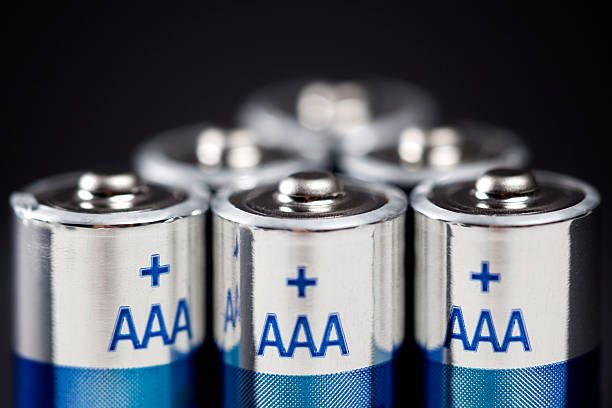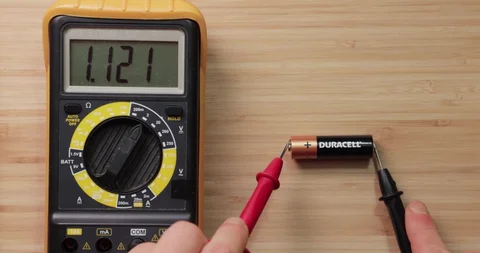AAA batteries power countless everyday devices in our homes and workplaces. Understanding their voltage characteristics ensures you select the right type for your needs while maximizing performance and safety. At VADE Battery, while we specialize in custom rechargeable solutions like 18650 Li-ion battery packs and LiFePO4 systems, we recognize the importance of understanding even standard battery technologies like AAA cells.
What is the Nominal Voltage of a Triple A Battery?
The nominal voltage of standard AAA batteries varies depending on their chemistry. Alkaline and lithium AAA batteries typically provide 1.5 volts, which is the industry standard for most consumer devices. However, if you choose rechargeable versions like nickel-metal hydride (NiMH) batteries, they usually deliver a slightly lower 1.2 volts.

This voltage difference becomes crucial when powering sensitive electronic devices. Some equipment designed specifically for 1.5V operation may underperform when using 1.2V rechargeable alternatives. For instance, digital cameras or high-powered flashlights might show reduced brightness or shorter runtime with NiMH batteries, even when fully charged.
For applications requiring consistent high-voltage performance, devices using our custom battery pack voltage configurations can be designed to deliver precise power requirements regardless of individual cell variations.
How Does Battery Chemistry Affect Voltage?
Battery chemistry fundamentally determines both voltage characteristics and performance attributes. The electrochemical reactions within different battery types create distinct voltage profiles that affect their suitability for various applications.
| Battery Type | Nominal Voltage | Rechargeable | Best For | Key Advantage |
|---|---|---|---|---|
| Alkaline | 1.5V | No | Low-drain devices | Cost-effective, widely available |
| Lithium | 1.5V | No | High-drain devices | Long life, temperature resistance |
| NiMH | 1.2V | Yes (500-1000 cycles) | Frequently used devices | Environmentally friendly, reusable |
| NiCd | 1.2V | Yes (300-500 cycles) | Legacy applications | Consistent discharge rate |
The internal chemical composition directly impacts how batteries perform under load. Alkaline batteries use zinc and manganese dioxide in a potassium hydroxide electrolyte, providing good general-purpose performance. Lithium batteries employ lithium and iron disulfide, offering extended life in extreme temperatures and high-drain applications.
For advanced rechargeable technologies, our lithium-ion battery basics guide provides deeper insights into modern battery chemistry and its applications.
How Many Volts Do Three AAA Batteries Produce?
When connecting multiple AAA batteries in series (positive terminal to negative terminal), their voltages add together. Three 1.5V AAA batteries in series will produce 4.5 volts (1.5V + 1.5V + 1.5V). This configuration is commonly used in devices requiring higher operating voltages, such as certain LED flashlights, digital cameras, and portable audio equipment.
The mathematical formula for calculating total voltage in a series connection is straightforward:
$$ text{Total Voltage} = text{Number of Batteries} times text{Voltage per Battery} $$
For three standard AAA alkaline batteries:
$$ text{Total Voltage} = 3 times 1.5text{V} = 4.5text{V} $$
For three rechargeable NiMH AAA batteries:
$$ text{Total Voltage} = 3 times 1.2text{V} = 3.6text{V} $$
This voltage difference (4.5V vs. 3.6V) explains why some devices may perform differently when switching between alkaline and rechargeable options. For more complex configurations, our series-parallel battery configurations guide explains how to achieve custom voltage and capacity requirements.
How to Check AAA Battery Voltage?
Measuring AAA battery voltage accurately requires a digital multimeter. The process is straightforward and provides valuable information about battery health and remaining capacity.

Step-by-step voltage testing procedure:
- Set your multimeter to DC voltage measurement (usually in the 2V or 20V range)
- Touch the red (positive) probe to the positive terminal (the bumped end)
- Touch the black (negative) probe to the negative terminal (the flat end)
- Read the voltage displayed on the screen
Interpreting voltage readings:
- Fresh alkaline AAA battery: 1.5-1.6V
- Good condition alkaline: 1.3-1.5V
- Depleted alkaline: Below 1.0V
- Fresh NiMH rechargeable: 1.2-1.4V
- Depleted NiMH: Below 1.0V
For more advanced diagnostic techniques, our battery load testing guide explains how to evaluate batteries under simulated real-world conditions.
What Factors Affect AAA Battery Voltage?
Several environmental and usage factors can significantly impact AAA battery voltage and performance. Understanding these variables helps maximize battery life and ensure reliable operation in your devices.
Temperature Effects
Temperature dramatically affects battery performance. Cold temperatures slow down chemical reactions inside batteries, reducing their ability to deliver power efficiently. At temperatures below freezing (32°F/0°C), alkaline batteries may lose up to 50% of their capacity, while lithium batteries maintain better performance in cold conditions.
Conversely, high temperatures accelerate chemical processes but can lead to increased self-discharge rates and shortened lifespan. Storing batteries above 80°F/27°C can reduce shelf life by 50% or more compared to room temperature storage.
Discharge Rate and Load Conditions
The rate at which current is drawn from a battery significantly impacts its voltage stability. High-drain devices like digital cameras, portable gaming systems, or LED flashlights pull current quickly, causing voltage to drop more rapidly than in low-drain applications like remote controls or wall clocks.
This phenomenon occurs because of internal resistance within the battery, which increases as the battery discharges. Under heavy loads, this resistance creates a voltage drop proportional to the current being drawn (following Ohm’s Law).
Age and Storage Conditions
Even when not in use, batteries experience self-discharge over time. This process accelerates with age and improper storage conditions. Humidity and moisture exposure can damage battery terminals and seals, potentially leading to leakage or increased internal resistance.
For maximum shelf life, store batteries in a cool, dry place away from direct sunlight and extreme temperatures. For proper storage techniques for larger battery systems, see our how to store lithium batteries safely guide.
Common Applications for Triple A Batteries
AAA batteries power a vast array of devices across household, professional, and specialized applications. Their compact size, relatively high energy density, and universal availability make them ideal for portable electronics.
Household Devices
In the home environment, AAA batteries commonly power:
- Remote controls for televisions, streaming devices, and air conditioners
- Wall clocks and timers where long-term reliability is essential
- Wireless keyboards and mice requiring lightweight power solutions
- Thermometers and weather stations that need consistent power
- Children’s toys with moderate power requirements
Professional and High-Performance Applications
In more demanding settings, AAA batteries power:
- Digital cameras where consistent voltage is crucial for proper operation
- Professional audio equipment like wireless microphones and headsets
- Medical devices including thermometers and personal health monitors
- Environmental sensors deployed in various conditions
- Emergency and safety equipment requiring reliable backup power
For high-drain applications, lithium AAA batteries often provide superior performance compared to alkaline alternatives. To understand the differences in depth, our lithium vs. alkaline batteries technical guide offers comprehensive comparisons.
What Happens If You Mix Different Types of AAA Batteries?
Mixing different types, brands, or ages of AAA batteries can lead to several problems affecting both performance and safety. This practice should be avoided whenever possible.
Performance Issues
When batteries with different chemistries or charge levels are combined:
- Voltage inconsistencies create unpredictable device performance
- Premature device shutdown occurs when the weakest battery depletes
- Efficiency losses result from mismatched internal resistances
- Erratic operation in sensitive electronics requiring stable power
Safety Concerns
More serious than performance issues are potential safety hazards:
- Reverse charging can occur when a depleted battery is used with fresh ones
- Leakage risk increases as weaker batteries may be overdischarged
- Overheating can result from uneven current distribution
- Possible rupture in extreme cases with severe mismatch
For optimal performance and safety, always use identical batteries of the same:
- Brand
- Chemistry
- Age
- Charge level
In larger battery systems, proper cell matching becomes even more critical. Our lithium ion battery pack components and BMS design guide explains how professional systems address these challenges.
How Long Do Triple A Batteries Last?
Battery lifespan varies dramatically based on chemistry, quality, usage patterns, and storage conditions. Understanding typical lifespans helps set realistic expectations and plan for replacement.
Shelf Life (Unused Storage)
When stored properly at room temperature (68-72°F/20-22°C):
- Alkaline AAA batteries: 5-10 years shelf life
- Lithium AAA batteries: 10-15 years shelf life
- NiMH rechargeable AAA: 3-5 years before significant capacity loss
- NiCd rechargeable AAA: 1-2 years due to higher self-discharge
Usage Duration
Actual runtime in devices depends heavily on power consumption requirements:
- Low-drain devices (clocks, remote controls):
- Alkaline: 1-3 years
- Lithium: 3-7 years
- NiMH: 3-12 months between charges
- Medium-drain devices (toys, wireless mice):
- Alkaline: 2-12 months
- Lithium: 1-3 years
- NiMH: 1-6 months between charges
- High-drain devices (digital cameras, gaming controllers):
- Alkaline: 2-30 hours of active use
- Lithium: 4-60 hours of active use
- NiMH: 2-20 hours between charges
For maximizing battery lifespan, our battery terminal corrosion prevention guide offers practical maintenance advice applicable to all battery types.
Can You Recharge Triple A Alkaline Batteries?
Standard alkaline AAA batteries are designed for single-use and are not safely rechargeable. Although specialized “rechargeable alkaline” batteries exist, attempting to recharge standard alkaline batteries presents serious risks.
Safety Risks of Recharging Standard Alkaline Batteries
Attempting to recharge standard non-rechargeable alkaline batteries can cause:
- Gas buildup within the sealed case
- Leakage of corrosive electrolyte
- Physical rupture or explosion
- Chemical burns from leaked materials
- Fire hazards from overheating
Rechargeable Alternatives
For applications requiring rechargeable solutions, choose batteries specifically designed for repeated charging:
- NiMH AAA rechargeable batteries: Most common replacements for alkaline AAAs with 500-1000 charge cycles
- Lithium-ion based AAA alternatives: Higher capacity but require special chargers
For larger applications needing rechargeable solutions, our custom 12V LiFePO4 battery systems offer superior cycle life and safety compared to traditional technologies.
FAQs About AAA Battery Voltage
What is the difference between 1.5V and 1.2V AAA batteries?
The 0.3V difference between alkaline (1.5V) and NiMH rechargeable (1.2V) batteries represents a 20% reduction in nominal voltage. While many devices work with either type, some voltage-sensitive equipment may underperform with 1.2V batteries. Digital cameras, high-brightness flashlights, and some medical devices typically perform better with 1.5V batteries.
How can I test if my AAA batteries are still good?
Besides using a multimeter to check voltage, you can:
- Use a battery tester designed for consumer batteries
- Try the “bounce test” (dead alkaline batteries bounce higher when dropped flat)
- Observe device performance in high-drain applications
- Check for physical signs like leakage or bulging
Why do my devices die suddenly with rechargeable AAA batteries?
NiMH rechargeable batteries maintain a relatively flat voltage curve during discharge until they suddenly deplete. This contrasts with alkaline batteries, which gradually decrease in voltage. This discharge characteristic means devices may work normally with rechargeable batteries until suddenly shutting off without warning, whereas alkalines might show gradually diminishing performance.
Can I use lithium AAA batteries in any device that takes regular AAA batteries?
Lithium AAA batteries (1.5V non-rechargeable type) can generally replace alkaline AAA batteries in most devices. However, some older or sensitive electronics with basic power management systems might not handle the more stable discharge curve of lithium cells. Always check device compatibility, especially for medical or safety equipment.
Is it normal for AAA batteries to get warm during use?
Slight warmth during use in high-drain devices is normal, but batteries should never become hot to touch. Excessive heat indicates either a problem with the device drawing too much current or a potential internal short in the battery. If batteries become hot, discontinue use immediately and properly dispose of them.
Understanding AAA battery voltage characteristics helps you make informed decisions about which type to use in your devices. While standard consumer batteries serve many needs, for applications requiring custom power solutions, VADE Battery offers specialized lithium-ion battery packs engineered for specific voltage, capacity, and environmental requirements.
For more information about advanced battery technologies and custom solutions, visit our comprehensive lithium battery guides or contact our engineering team for specialized consultation.


